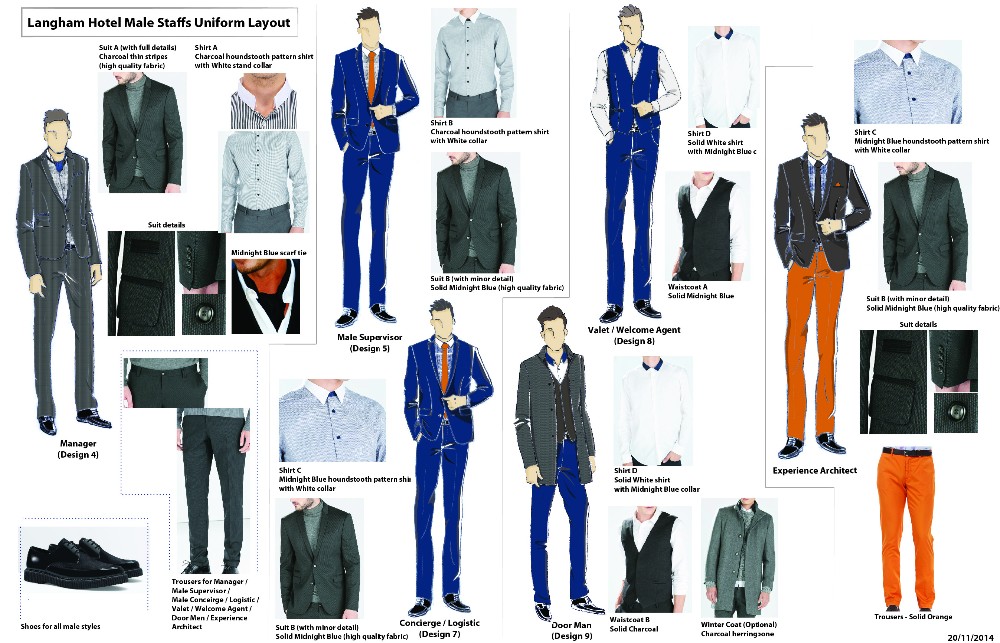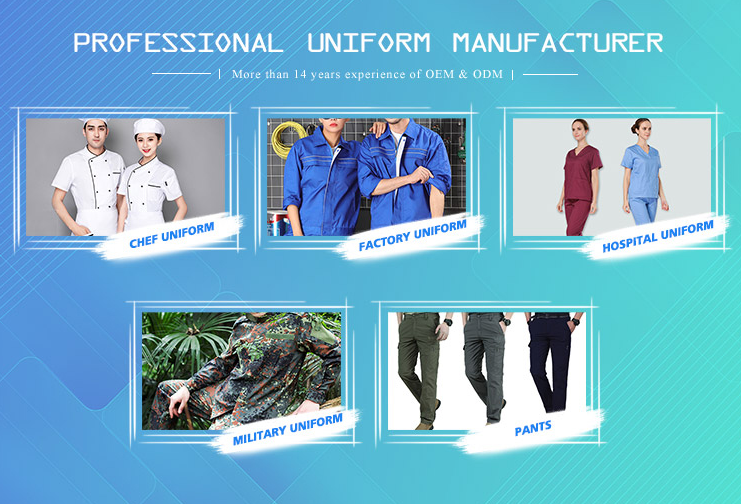Uniform style design
It can be positioned and keyed according to occupational characteristics and requirements. Clothing style design. Based on grasping the overall style and style of clothing, it can be positioned and designed according to occupational characteristics and requirements, such as collar, placket, Sleeve shape, pockets, hem, etc.
1. Collar design
Collar type is an important part of professional clothing design. Collar types include stand-up collar, stand-up lapel, lapel, lapels, and collarless. From the aspect of practicality, the form of collar should be designed according to professional characteristics. For example, working clothes in mining and construction industries are labor-intensive and vulnerable to the influence of climate and harmful substances. The collar type is often in the form of a stand-up collar. The choice of knit fabrics with large stretchability such as ribs is to improve the touch of the collar on the neck, especially the impact on the neck when the collar is closed. From the aspect of identification, the collar design is often inlaid with different colors and materials. Fighting embodies the identification symbolism and decoration of professional clothing. For example, a suit can become a professional uniform in a certain industry by simply designing the collar with different colors. In addition, neckties, bow ties, collar flowers, etc. are closely related to the shirt collar type and outer collar type, and should not be ignored in the design.
2. The placket design
The placket is mostly in the forerunner of the clothing, and directly affects the change of the collar shape. The placket is divided into exposed placket, concealed placket, buttons and zippers. Ming placket and buttons can be used for decoration. But for the design of protective clothing, the form of concealed placket is usually adopted to prevent the placket from getting caught in the work. In special environments, metal buttons and zippers are forbidden to be used in professional clothing at work sites such as electrical equipment. In addition, there are side plackets and back plackets, which are determined according to the nature of the work object. The form of the placket has changes such as folded placket, oblique placket, curved placket, and placket. The use of inlays, hemming, and embroidery on the placket is a common method for designing clothing and dresses in the service industry.
3. Sleeve design
Sleeve design means that the length of the sleeves, the fatness and thinness of the sleeves and the form of the cuffs should be determined according to the type of work and occupational characteristics. For clothing used in equipment assembly work, sleeves should not be too short or too thin to facilitate climbing, climbing, pulling and other operations. If necessary, add live pleats at the arm joints of the sleeves. As for the clothing of waiters in the catering industry, the sleeves should not be too long or too fat, so as not to cause trouble during service. There are generally two types of cuffs for professional tooling: elastic type and adjustable buckle type. The main function is antibacterial and antifouling. In addition, pockets or armbands with marking function can be added to the cuffs as needed.
4. Pocket design
According to the requirements of practicality, the pockets have flat patch pockets, diagonal pockets, three-dimensional pockets, inner patch pockets, and composite open patch pockets. According to the requirements of professional tooling, the pocket should be convenient for placing various handy tools, and the structure of the pocket should not be open during operation to prevent it from being pulled, hung or falling into the sundries. General pockets are equipped with flaps or buckles or zippers at the mouth, but the convenience of taking and placing tools should be considered when designing. The logos, texts, and badges of companies and organizations are usually embodied on the chest pockets of the jacket.
5. Hem design
Because of the nature of the work and the environment, the hem of the professional tooling must be tightened with elastic or drawstrings. The purpose is to prevent environmental objects, equipment, etc. from hanging or pulling the clothing during operation. The length and width of the hem and skirt of the female service staff in the business and restaurant industry should be appropriately designed according to the area of their business premises and the space formed by the placement of objects.



Our Uniform Design Team
Upon your request, our design team can support to provide design for hotel uniform design, hotel staff uniform, hotel housekeeping uniform, uniform for hotel receptionist, bellboy uniform for hotel, hotel manager uniform, hotel reception uniform, hotel reception uniform design, hotel uniform for waitress, hotel concierge uniform, uniform hotel front office, hotel doorman uniform, hotel bellboy uniform, receptionist hotel uniform for front desk staff, uniform for hotel, hotel maid uniform etc.


As a professional uniform manufacturer, we have professional design group, providing custom service for your jeans. If customer have samples, we can make it according to customer samples. If customer have no samples,we can design it according to customer idea, or customer can choose our factory samples.




























